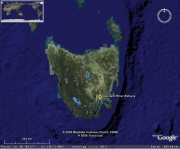Biosphere | Zoology | Echinoderms
Type of resources
Topics
Keywords
Contact for the resource
Provided by
Years
-
This study assessed the spatial and temporal (horizontal and vertical) distribution of Asterias amurensis larvae in the Derwent Estuary and adjacent Storm Bay, SE Tasmania. Horizontal transport and development was assessed by collecting plankton samples at 2 or 4 week intervals, from July to December 2001, at 4 sites in the Derwent Estuary and 6 sites in Storm Bay. The effects of light and salinity on vertical distribution of larvae was examined over a 24 hour tidal and diel cycle.
-

Reef Life Survey is a program that trains and assists a network of skilled and committed recreational divers to cost-effectively assess the state of the inshore marine environment at the continental scale. The program uses standardised underwater visual census methods employed by SCUBA divers to survey fish and invertebrate species and to record macroalgal and coral cover using photo quadrats - this record refers to the website for this program. By standardising techniques and establishing a monitoring system on a nation-wide scale, the program addresses many of the current problems associated with managing the marine environment, including the paucity, patchiness and variable quality of data on the distribution of and trends to marine biodiversity. A central database is managed for the storage, analysis and dissemination of data collected nationally, with a publicly-accessible web-based portal. The website allows information collected on Australia's marine environment to be accessed in a meaningful form by policy-makers and the general public, including recreational groups, scientists and industry. It also has information and resources for particpating divers and those wishing to become involved. The dataset generated by recreational divers will provide a national framework for monitoring the state of the inshore environment and the identification of those threats and locations of greatest conservation concern. This record points to the online resource for Reef Life Survey: http://www.reeflifesurvey.com/
-

In the Derwent Estuary (south eastern Tasmania, Australia), the introduced northern Pacific seastar Asterias amurensis is highly abundant and fecund when associated with anthropogenic structures (wharves and marinas). Based on modelled predictions of fertilisation success, seastars at wharf 'hotspots', whilst representing <10% of the total population in the Derwent Estuary, and concentrated in <0.1% of the total area, contribute up to >80% of total larval production in the estuary. Reproductive potential of populations at wharf and control sites was quantified (in terms of individual capacity and spatial characteristics of the population. A large scale survey was undertaken in the Derwent estuary (to 27m) to determine spatial distribution of the species. Zygote production (i.e. number of fertilised eggs) was used as a measure of reproductive output and was simulated using empirical estimates of spatial and reproductive parameters of the adult seastars in a spatially explicit model of fertilization (developed by A. Morris and C. Johnson).
-

This study reports on previously undescribed predation on Asterias amurensis in the Derwent Estuary, Tasmania by the spider crab Leptomithrax gaimardii (Milne Edwards). Specifically, this study describes the predatory interaction between the spider crab and A. amurensis and quantifies patterns of sub-lethal injuries inflicted on the seastar during a localised aggregation of the spider crab.
-
The predators of Centrostephanus rodgersii, were identified using remote video monitoring. Experiments were performed in two eastern Tasmanian regions, the Maria Island Marine Reserve (MIMR, 42° 35.26'S, 148° 3.03'E) and the Crayfish Point Research Reserve (CPRR, 42° 57.37'S, 147° 21.30'E). The impact of fishing on these predators, and ultimately on C. rodgersii, was examined by comparing survival of C. rodgersii on reefs inside no-take Marine Protected Areas (MPAs) (high predator biomass) relative to fished reefs (low predator biomass). The size-specific nature of predation interactions was examined in context of size-selective fishing pressures within the sea urchin's extended range.
-
A comparison was made of sediments and associated macrobenthos at sites sampled within 42 fish farm leases distributed across Tasmania. Several key biotic and abiotic metrics recommended in previous studies for assessing environmental impacts of fish farm waste were investigated.
 IMAS Metadata Catalogue
IMAS Metadata Catalogue